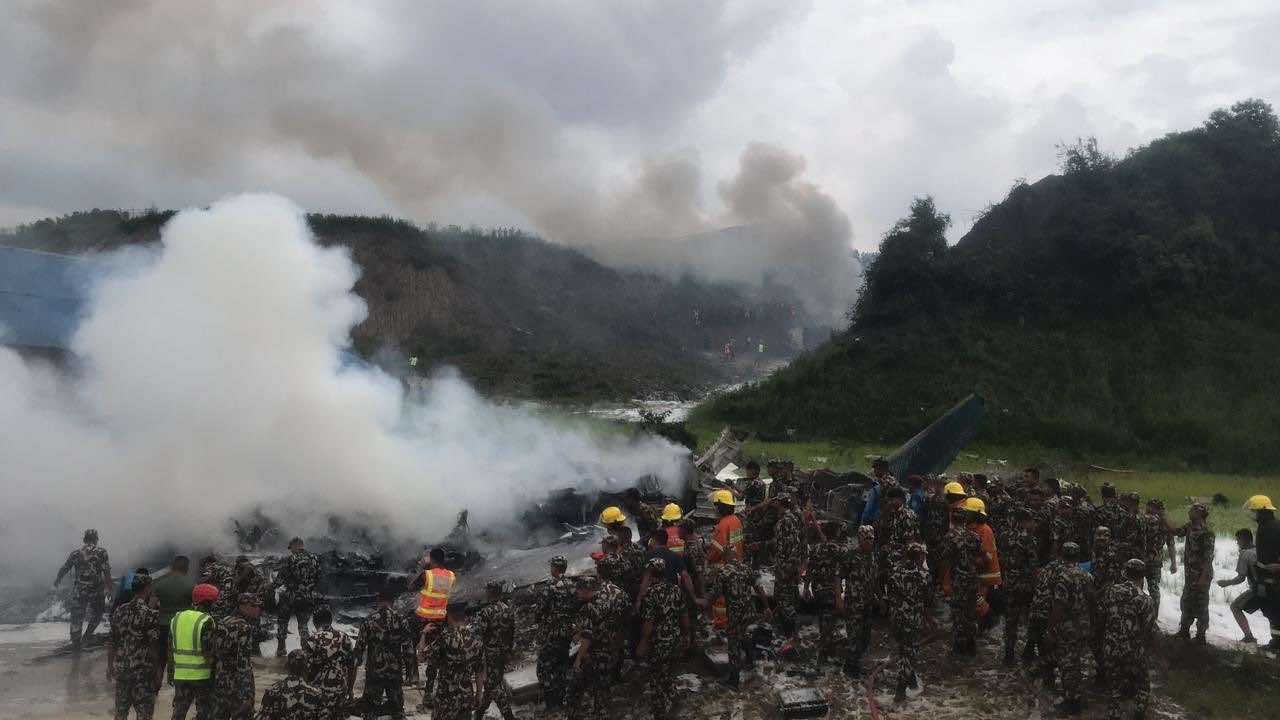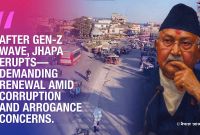Tragedy at Tribhuvan International Airport: The Crash of Saurya Airlines Flight

Date: July 24, 2024
Location: Tribhuvan International Airport, Kathmandu, Nepal
The Accident
On the morning of July 24, 2024, a tragedy unfolded at Tribhuvan International Airport (TIA) in Kathmandu, Nepal. Saurya Airlines flight, bound for Pokhara, crashed shortly after takeoff, leading to one of the deadliest aviation disasters in recent years. The aircraft, carrying 19 people, including the crew, veered off the runway to the right and crashed on the eastern side of the airport shortly after becoming airborne.
Captain Manishratna Shakya was the sole survivor of this horrific accident. He was rescued from the cockpit, critically injured, and immediately taken to the hospital. The remaining 18 passengers, including crew members, were tragically killed.
Nepal's Aviation Safety Concerns
The accident has again raised serious concerns about aviation safety in Nepal. The country has a history of frequent air accidents, which has led to the European Union blacklisting Nepal's airlines from entering EU airspace due to safety concerns. Experts have emphasized the urgent need for improvements in Nepal's aviation safety standards.
The Flight and Crash Details
The Saurya Airlines aircraft departed from the "Zero Two" runway at TIA, heading towards the "Two Zero" end. The flight was a routine test run to Pokhara as part of a C-Check—a comprehensive inspection performed every 18 to 24 months to evaluate an aircraft's structure, systems, and parts.
Seconds after takeoff, the plane became uncontrollable, veering to the right before crashing. The impact split the aircraft into two, leaving debris scattered across the runway. The crash scene was horrific, with parts of the aircraft engulfed in flames.
Rescue Efforts
Despite the grim situation, rescue efforts began immediately. Captain Shakya was found alive in a crushed cockpit section near the nose of the plane. Photos released by the police showed him with blood-stained face, indicating the severity of his injuries. The windshield had to be smashed to extricate him from the wreckage, a testament to the rescue team's quick response and expertise.
Medical Status of Captain Shakya
Captain Shakya was rushed to Kathmandu Medical College Teaching Hospital in Sinamangal, where he is receiving treatment. According to Dr. Meena Thapa, the captain sustained head and facial injuries, along with a fractured spinal cord that requires surgery within the next few days. Although his condition is not immediately life-threatening, doctors remain cautious as head injuries can have delayed effects. He has been placed in the Neuro ICU for 48-hour observation.
Government Response
Prime Minister KP Sharma Oli visited the hospital to meet Captain Shakya and expressed his support and well-wishes. As Captain Shakya was being wheeled into the operating room, he raised his right hand in a gesture of acknowledgment and gratitude toward the gathering officials and medical staff. In a meeting at the hospital, officials briefed the Prime Minister on the ongoing rescue operations and investigations.
Cabinet Decisions and Investigation Commission
In response to the accident, the Nepalese Cabinet has formed an investigation commission led by former Director General of the Civil Aviation Authority of Nepal (CAAN), Rati Shakya. The commission is tasked with presenting a report within 45 days. Members of the commission include a captain from Nepal Airlines, an engineer from Shree Airlines, an associate professor from Pulchowk Engineering Campus, and a technical officer from the Ministry of Tourism.
Investigation of the Accident
According to Minister Badri Prasad Pandey, it is premature to determine the exact cause of the accident. The aircraft was deemed technically sound and was conducting a routine C-Check flight. However, questions have been raised regarding the presence of unrelated personnel on board, which is strictly against aviation regulations.
The Aircraft's History
The ill-fated aircraft was manufactured in Montreal 21 years ago and was delivered to Saurya Airlines in 2017. The flight was neither a regular passenger flight nor a charter service; it was intended for a technical check. Saurya Airlines, known for its regional operations, has been facing scrutiny following the accident.
According to Subhash Jha, spokesperson for Tribhuvan International Airport, C-Checks involve detailed inspections of an aircraft's structure, systems, and components, and are critical to ensuring flight safety.
Aviation Safety Concerns
Captain Shakya had previously highlighted technical aspects of aircraft safety, particularly the impossibility of opening a plane's door while in flight due to pressurization. This knowledge underlines the complexity of aviation operations and the need for strict adherence to safety protocols.
The accident has brought to light several critical issues:
-
Presence of Unrelated Personnel:
The presence of non-essential personnel on the flight, including family members of the technical staff, is a clear violation of aviation rules. Ferry flights are meant only for crew and technical staff, not passengers. -
Aviation Experts' Views:
Aviation experts have reiterated that the frequent air accidents in Nepal have led to the EU blacklisting, posing significant challenges to the country's aviation safety reputation. Aircraft undergoing maintenance should not carry anyone other than authorized personnel. -
Role of Aviation Regulators:
Aviation experts assert that regulators should have conducted a thorough check of those boarding the aircraft for a maintenance flight. Proper oversight could have prevented the disaster or minimized the human toll.
Government's Condolence
The government has expressed profound shock over the tragedy, offering condolences to the families of the deceased. It declared a national day of mourning, with flags flying at half-mast across the country. Additionally, the government extended wishes for the speedy recovery of injured Captain Shakya.
Latest Developments
As investigations proceed, initial findings suggest a possible mechanical failure in the flight control system. The commission is working with international aviation experts to analyze the flight data recorders retrieved from the crash site. Meanwhile, the government is reviewing aviation safety policies and conducting rigorous inspections of all domestic airlines to prevent future tragedies.
Conclusion
The crash of Saurya Airlines has once again brought Nepal's aviation safety challenges to the forefront. The loss of 18 lives has cast a pall of sorrow over the nation, underscoring the urgent need for enhanced safety measures. As the investigation unfolds, it is hoped that lessons learned from this tragic incident will lead to substantial improvements in aviation safety, ensuring the skies over Nepal remain safe for all travelers.
Additional Information:
-
Flight Data and Investigation:
Preliminary analysis of the flight data recorder indicates a potential malfunction in the aircraft's control systems. Investigators are examining whether maintenance procedures were adequately followed and if the aircraft's age played a role in the accident. -
Eyewitness Accounts:
Witnesses at the airport reported seeing the aircraft tilt sharply to the right immediately after takeoff, followed by a loud explosion as it impacted the ground. Many described the scene as chaotic, with emergency services rushing to the crash site. -
Safety Measures and Recommendations:
The investigation commission is expected to recommend a series of safety measures, including stricter enforcement of ferry flight regulations and enhanced training programs for pilots and technical staff. There is also a push for modernizing Nepal's aviation infrastructure to meet international standards. -
Public Reaction and Advocacy:
The accident has sparked widespread public outcry and calls for accountability from both Saurya Airlines and regulatory bodies. Aviation advocacy groups are demanding transparency in the investigation process and a commitment to implementing safety reforms. -
International Assistance:
The Nepalese government has sought assistance from international aviation safety organizations to aid in the investigation. Experts from countries with advanced aviation safety records are collaborating to identify the accident's root causes and provide recommendations for preventing similar incidents.




![From Kathmandu to the World: How Excel Students Are Winning Big [Admission Open]](https://nepalaaja.com/img/70194/medium/excel-college-info-eng-nep-2342.jpg)
